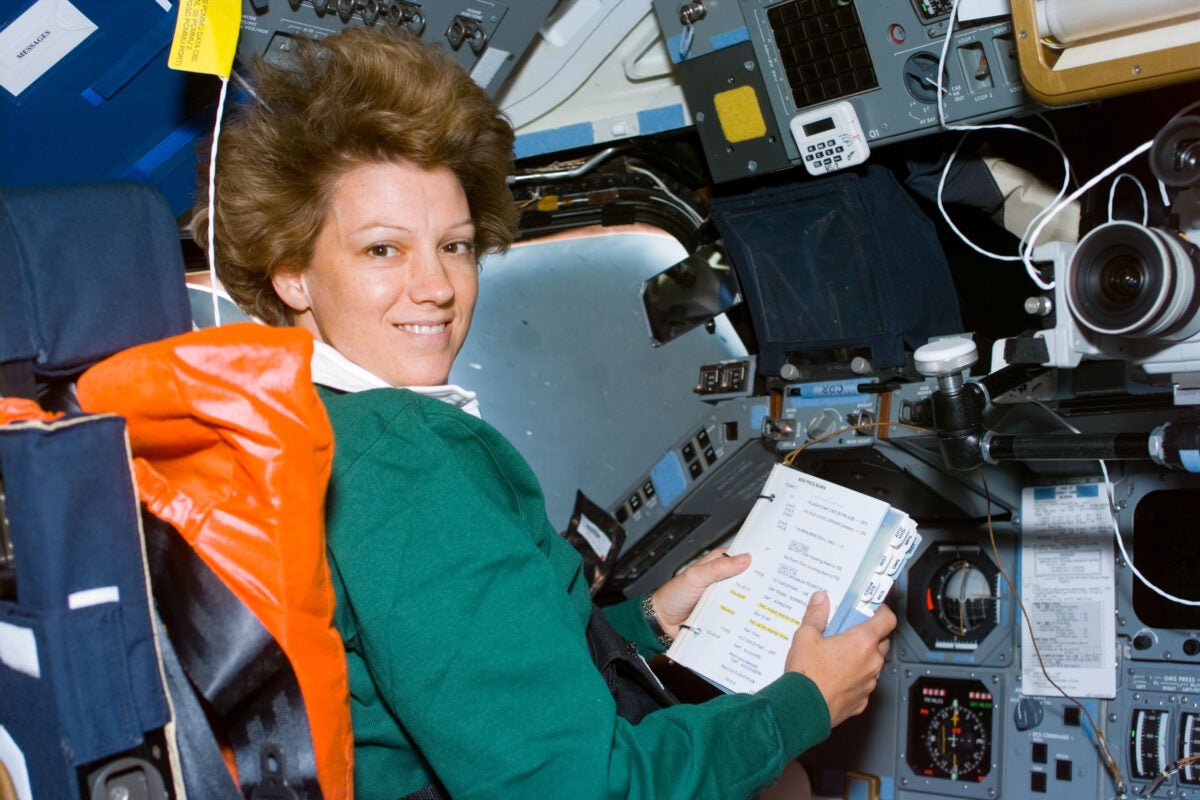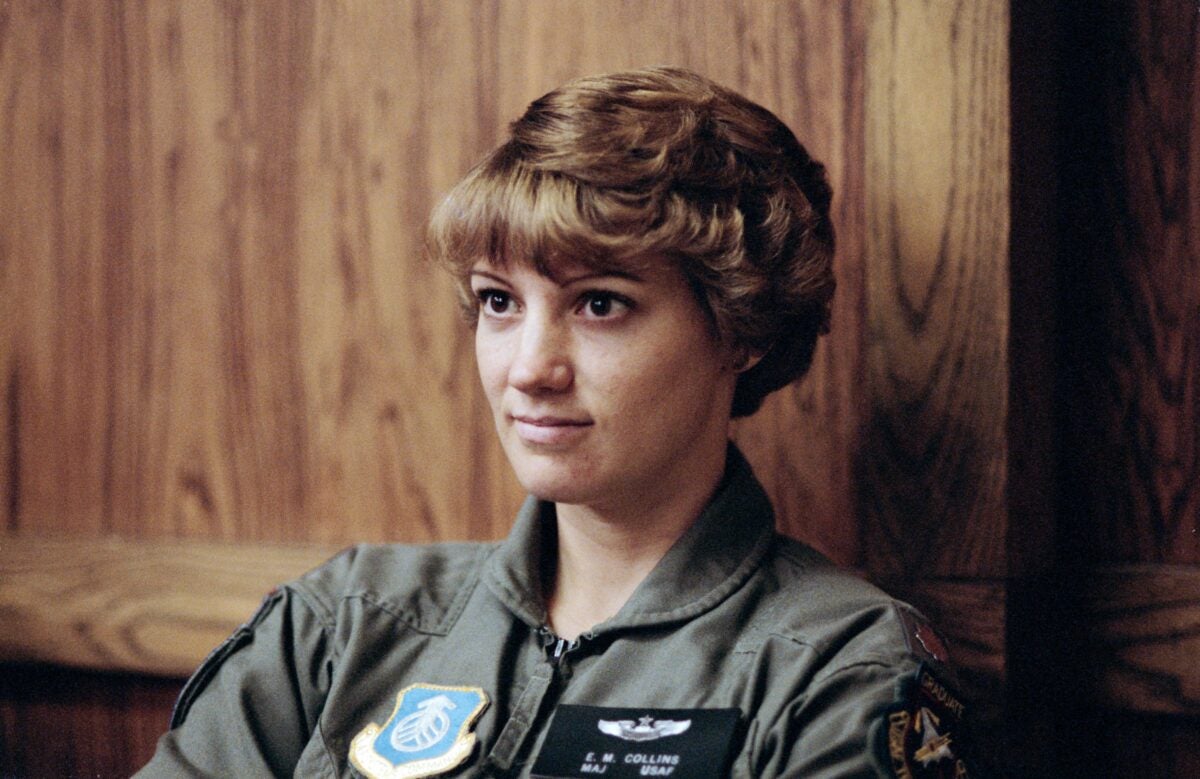
Twenty-five years ago, Eileen Collins became the first woman to command a spaceflight. A test pilot, mathematician, and trailblazer, this soft-spoken Air Force Colonel helmed space shuttle Columbia when it roared into Florida’s post-midnight darkness on July 23, 1999. Her STS-93 crew deployed NASA’s $1.5 billion Chandra X-ray Observatory — at 25 tons, it was the shuttle’s heaviest-ever payload—to unveil the high-energy universe.
Of Irish ancestry from County Cork, Collins grew up in Elmira, New York, once the site of a notorious prison for Confederate soldiers during the Civil War. “Our town produced its fair share of famous citizens,” she acquiesced in her memoir, Through the Glass Ceiling to the Stars. Filmmaker Hal Roach, fashion designer Tommy Hilfiger, and writer Mark Twain in his last years were among them.
Elmira also was home to the National Soaring Museum, atop Harris Hill, and a young Collins gleefully watched gliders wheeling overhead. “My father didn’t have the money to give me flying lessons when I was a child,” she told a NASA interviewer, “so I had to wait until I was 16, get a job and save up money.”
A pilot from the beginning
Her aviation career began with piloting Cessnas, moved on to a glider’s license, and finally the military. She studied mathematics and later flew Northrop’s T-38 supersonic jet, Lockheed’s C-141 strategic airlifter, and instructed junior pilots in Cessna’s T-41 trainer.

By 1990 she had also experienced two master’s degrees, test pilot school, and an assistant professorship at the Air Force Academy. By then, NASA officials selected her as its first female shuttle pilot. In 1995, aboard STS-63, Collins piloted Discovery within 30 feet (10 metres) of Russia’s Mir space station, a feat that won her the coveted Harmon aviation trophy.
In 1997, aboard STS-84, she piloted Atlantis to dock with Mir, exchanging crew members and delivering 7,300 pounds (3,300 kilograms) of cargo. With two flights to her credit, Collins now was eligible for command. A lifelong interest in astronomy drew her to the Chandra mission and in 1998 she was chosen as STS-93’s commander.
The announcement by First Lady Hillary Clinton occurred in the White House’s opulent Roosevelt Room. “To discover new worlds,” NASA Administrator Dan Goldin told a camera-toting media throng, “we must break down old barriers.”
Women in aviation
Collins’ triumph capped a list of female accolades in the 20th century — a century that saw women steadfastly reject imposed societal norms, earning the rights to vote, to work, to be educated and to hold office.
Women had long been captivated by aviation’s entrancing allure: from Aida de Acosta, first to fly a motorized aircraft in 1903, to Raymonde de Laroche, first to earn a pilot’s license in 1910, and from Georgia “Tiny” Broadwick, the first female parachutist in 1913, to Amelia Earhart, who soloed across the Atlantic in 1932 but died during a global circumnavigation attempt in 1937.
Later, Jacqueline Cochran broke the sound barrier for women in 1953, Betty Miller soloed across the Pacific in 1963 and Jerrie Mock flew alone around the world for the first time in 1964. “It took a lot of courage to fly as a woman” in those days, an admiring Collins reflected, “when that really wasn’t a woman’s place.”
Columbia launches
By July 1999, after multiple delays, STS-93 was finally ready to go. Two launch attempts that month were scrubbed: the first by a sensor malfunction, the second due to lightning risks. Late on the evening of July 22, Collins and her crew strode out to the launch pad, filled with third-time-lucky hopefulness.
Columbia blasted off at 12:31 a.m. EDT, her three main engines and twin solid rocket boosters turning the midnight hour into instant daylight across the slumbering Florida. But all was not well.
During ignition, a liquid oxygen post-pin fell loose, striking the inner surface of one of the main engines’ nozzles, tearing coolant tubes and precipitating a hydrogen leak. An electrical short then disabled one of two backup engine controllers. The astronauts made it to orbit, deployed Chandra, and returned safely to Earth five days later, but the hair-raising incident grounded the shuttle fleet for six months.
Collins’ success ended a century of flight which saw not just female aviators, but the first women to conquer space. Russia’s Valentina Tereshkova became the first woman cosmonaut in 1963. A factory seamstress, her lowly status was cynically exploited by the Soviet Union to endorse a narrative that under communism “anyone” could reach space.
The US and Soviet rivalry
But the reality that no other Russian woman followed Tereshkova for two decades undid that narrative, exposing its fiction. Meanwhile, in 1978 NASA chose six female astronauts — including Sally Ride, who became the first American woman in space in 1983, and Kathy Sullivan, the first U.S. woman spacewalker in 1984.
In an act of cleverly timed propaganda, Soviet cosmonaut Svetlana Savitskaya flew in 1982, then again in 1984 and did a spacewalk, passing Ride and Sullivan as the first woman to fly two missions and perform an Extravehicular Activity (EVA).
Few Western observers harbored illusions that Savitskaya’s EVA was anything more than an ideological stunt. And in another case of geopolitical one-upmanship, Savitskaya trained to command an all-female mission in 1986 to coincide with International Women’s Day. But the flight was scratched following problems with Russia’s Salyut 7 space station.
By decade’s end, ten U.S. women had flown — including Anna Fisher, the first mother in space — compared to two from Russia. And by the millennium’s end, that figure rose to 36 women from six nations, including the first female astronauts from Canada in 1992, Japan in 1994, France in 1996 and the first national space traveller from the United Kingdom.
As the last millennium ended, women spacewalked outside space stations and serviced the Hubble Space Telescope, did scientific research and flew space shuttles. In 1991, Helen Sharman made Britain the first nation whose first space traveller was a woman. And in 1996, America’s Shannon Lucid logged a record 188 days on a single mission.
With the current millennium, the records continued. In 2001, Susan Helms made the longest EVA by a woman, lasting eight hours and 55 minutes. And in 2008, Peggy Whitson concluded her second long-duration International Space Station stay with a running total of 376 days: the first woman to spend a cumulative year off the planet.
Whitson also was the first female ISS commander, the opening weeks of her 2007–2008 increment happily coinciding with the arrival of Discovery, helmed by Pam Melroy. It marked the first time that two space vehicles were simultaneously commanded by women. Whitson’s later career included two more ISS missions and she currently has logged 675 days, longer than any other female space traveller.
Women also reached orbit from South Korea in 2008, China in 2012, Italy in 2014, Saudi Arabia in 2023 and Belarus in 2024. U.S. astronauts Christina Koch and Jessica Meir made the first all-female spacewalk in 2019. And in 2020, Koch returned home after a continuous 328 days, the longest-yet mission by a woman. She is now training for Artemis II and will become the first female Moon voyager.
The legacy of Eileen Collins
Female commanders followed rapidly in Collins’ footsteps. Pam Melroy (today NASA’s deputy administrator) and Susan Kilrain served as shuttle pilots, Melroy becoming the second woman to command a space flight. Four women, including Italy’s Samantha Cristoforetti, helmed the ISS. And three women have led SpaceX Dragon flights.
Today, women represent 12 percent of space travelers. Counting suborbital Blue Origin and Virgin Galactic flights plus orbital missions, they flew for 15 sovereign countries and included the first astronaut with a prosthesis, a film actress, a mother-and-daughter duo from Antigua and Barbuda and the first national astronauts of Egypt and Pakistan.
All of them owe a tip of the hat to Eileen Collins, who a quarter-century ago role-modeled for women worldwide that even the sky ought not impose limits to their ambitions.









